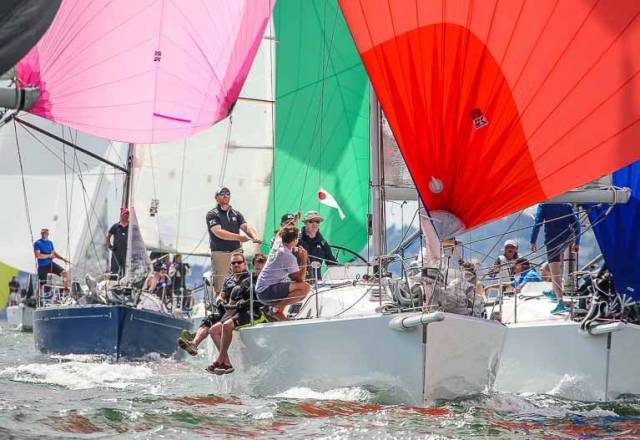With the advent of high–tech construction, most upwind sails are now being manufactured in specialist facilities in the likes of Hong Kong, Sri Lanka and South Africa. However, some sails are still being made in Ireland in a few lofts. One of these is UK sails in Crosshaven which still has the ability to build sails in Ireland. Here, Barry Hayes, Director of UK Sailmakers Ireland, explains how sails are designed and constructed. The firm recently provided four new downwind sails for Paul O'Higgins JPK 10.80 Rockabill VI and two of these were manufactured in Crosshaven in Cork Harbour.
High–tech upwind sails are now all made on moulds, such as the Titanium and Uni Titanium upwind sails produced by UK Sails at its uber modern new manufacturing facility in Hong Kong.
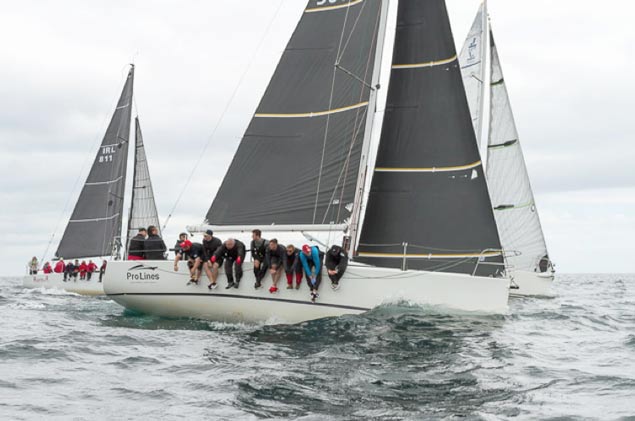 The A35 Waterford yacht Fools Gold on her way to winning Sovereigns Week in 2017 with her UK Sails Uni Titanium Main and J2 Jib Photo: Bob Bateman
The A35 Waterford yacht Fools Gold on her way to winning Sovereigns Week in 2017 with her UK Sails Uni Titanium Main and J2 Jib Photo: Bob Bateman
However, downwind sail construction has not changed significantly (apart from Code Zero sails) over the years with nylon type spinnaker cloths still being provided by the likes of Dimension and Contender.
The design of these downwind sails though has changed significantly and updated software programmes ensure that the optimum shapes are always being reproduced, whether the sails are built in Hong Kong or in Crosshaven.
UK Sails also manufactures Panel upwind sails in Crosshaven for various classes and the loft employs seven or more staff throughout the year.
So, how is a sail made from start to finish?
Once the customer has ordered the sail. Then we start designing the sail in 3D real-time view.
We get the measurements from the boat then input these into the design programme. They will then create a boat in a real 3D view for us to design the sail from. From this boat, we will work out the sheeting angles and the overall size of the sail.
For example, if the boat needs a new A1(asymmetric light air reaching sail) we will work out the working angle and the size based off the current working sails and give advise if that needs to be changed. Mostly spinnaker sizing works on Displacement. A heavy boat needs a bigger sail. There are limitations, however, such as mast height. If you have a heavy boat with a short mast, you cannot just increase the sail size by making it wider as there are certain ratios that work well and others don’t. Likewise, if a boat has a masthead halyard off a tall mast, and does not need a very large spinnaker because the boat is light, then that can be a problem, as you end up with tall, narrow spinnakers. In this case, it can be effective to lower the halyard position so you can then make optimum ratio sails.
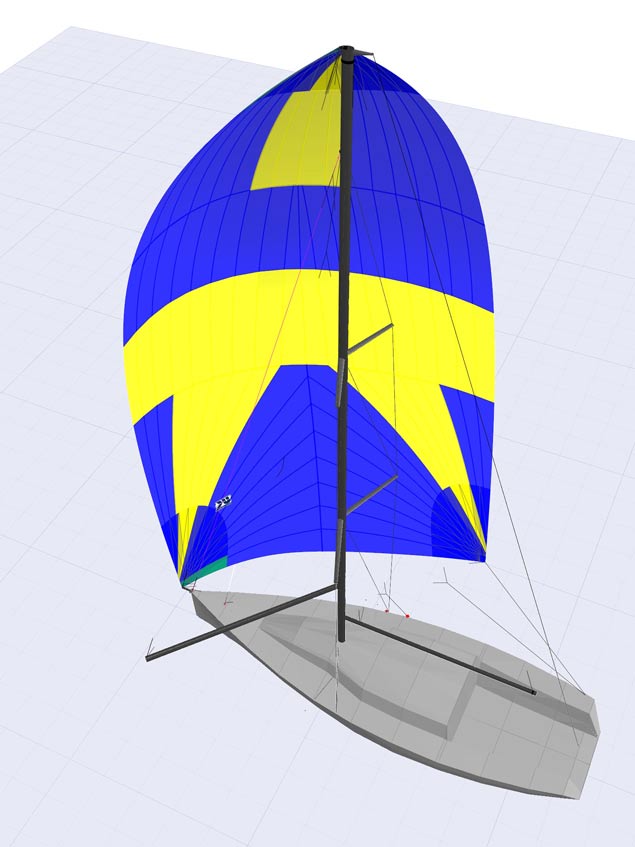 3D spinnaker design
3D spinnaker design
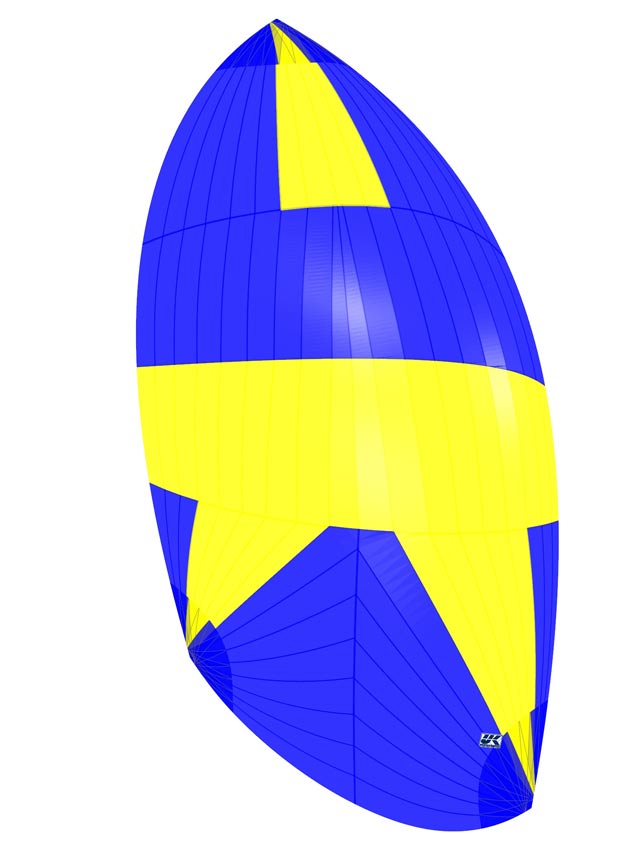
Once we have worked out the geometry of the sail. Then we will work out the design. Size and shape. So the sail is the correct size and shape for the working angles it is being used in. From there we will work out the colours the customer wanted and the patch sizes.
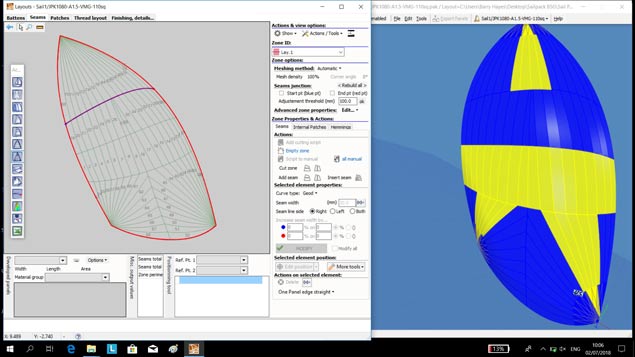
The seam sizes and patch sizes are different for each boat type and boat size. This is based on years of experience, knowledge of the design and how the sail is used, such as if it is being used for offshore or inshore racing.
When all of the sail is designed we then cut out the sail on the plotter. We take each panel and nest them as tightly together as we can to keep the waste to a minimum. Its normal with a spinnaker to have, say, 10% waste for a 40-foot boat. It varies with each sail and size.
Once we have nested the cloth it is then cut out on our 46 ft cutting table called a plotter. This machine can cut out a 40-foot kite in a day (10 hours). This is a normal plotting time for a big sail. The plotter will cut each panel out, number it and draw the seams.
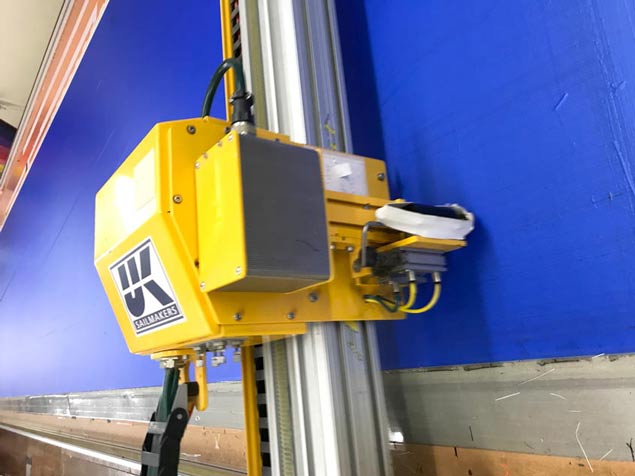 UK Sails plotter working on Rockabill VI's A 1.5 Spinnaker
UK Sails plotter working on Rockabill VI's A 1.5 Spinnaker
From these cut-out panels, we will put each panel together on the seaming table. This is a very critical point of the process. As the tension on each seam has to be exactly the same. You need lots of experience to do this job and it takes a really good technique. This normally takes about three to four years of experience to get this right.
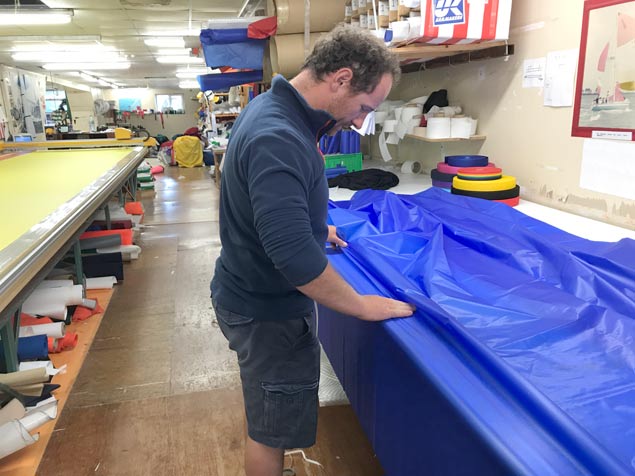 Graham Curran, Director, Uk sails Ireland, attaching the panels at the seaming table
Graham Curran, Director, Uk sails Ireland, attaching the panels at the seaming table
When we stick every seam we will fly the seam by holding it up to the light to check the seam is smooth and ready to be sewn. Most sails are put together in sections. A 40–ft spinnaker will have five main sections. For a dacron headsail, it can have up to 16 panels or four sections. Having the sail in sections makes it easier for handling and putting sections together.
Once you have the panels ready they go to the sewing machine for sewing. This the tricky part as you need to really concentrate and make sure you don’t put a needle wrong. If you stitch out of the seam it will compromise the sail integrity.
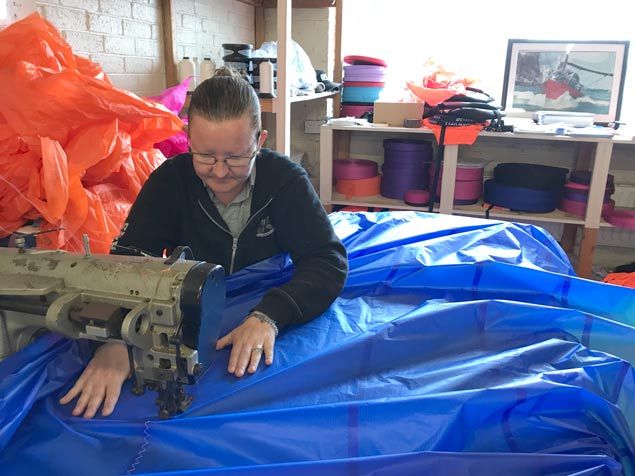 Claire Morgan, Director, UK Sails Ireland, sewing the panels
Claire Morgan, Director, UK Sails Ireland, sewing the panels
All the seams will be sewn and triple stitched. Single or double depending on the size and type of sail which is specified by the designer.
Now the whole sail is together and is then faired to the size. So the luff leech and foot are smooth and a fair line.
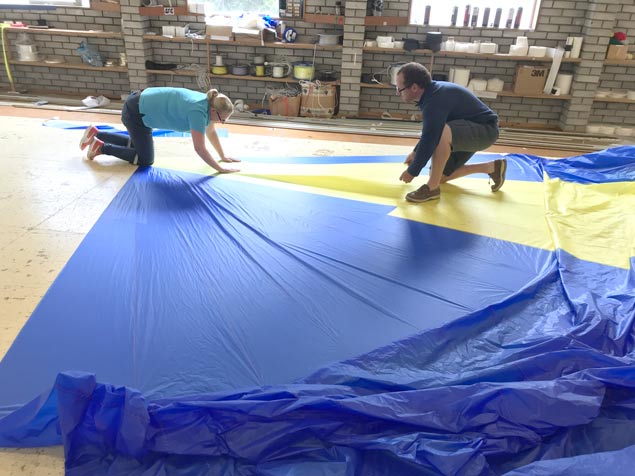 Cleo Watkin and Graham Curran fairing the sail
Cleo Watkin and Graham Curran fairing the sail
This takes great skill and a good eye to make sure the flying shape or the sail is right. Having too much hollow or too much girth will create a sail that’s slow or too hard to trim. So this has to be correct. Getting this right takes experience and practice.
Once the outline of the sail is finished the patches go on. Each panel of the patch is glued down and sewn again onto the sail.
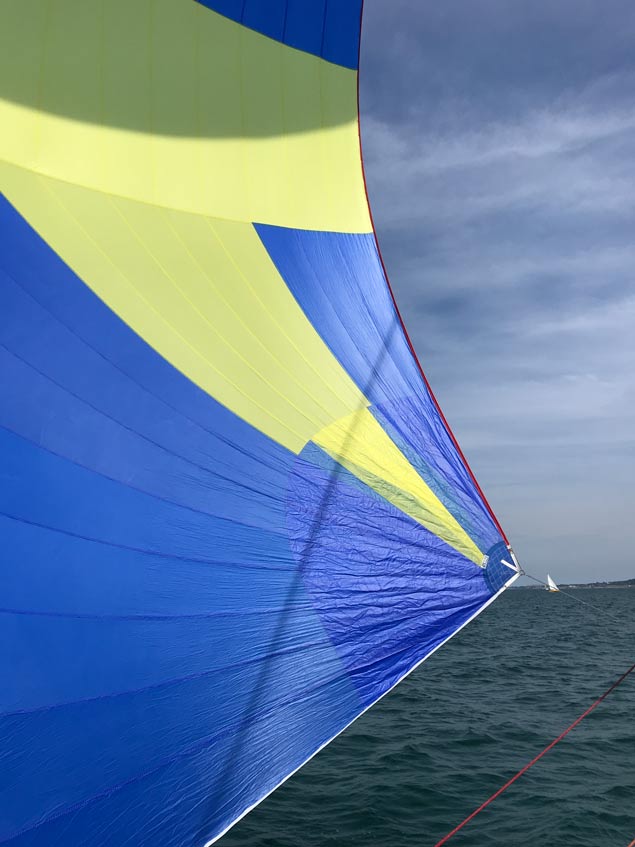
The laying of these patches onto the sail has to be done smoothly. So flattening the sail and adding the patches to the panels is tricky work. The sail is pinned out in different areas to make the sail flat so the patches go down correctly.
The sail then heads for finishing. The corners of the sail get all the rings, webbing and hand sewing put on the sail. This type of work gets done on the big sewing machine with a very heavy tread. It uses waxed thread so it doesn’t wear down over time. As the rings in the corners are pulled hard on different points of sailing they are the most worked parts of the sail and the main point of load.
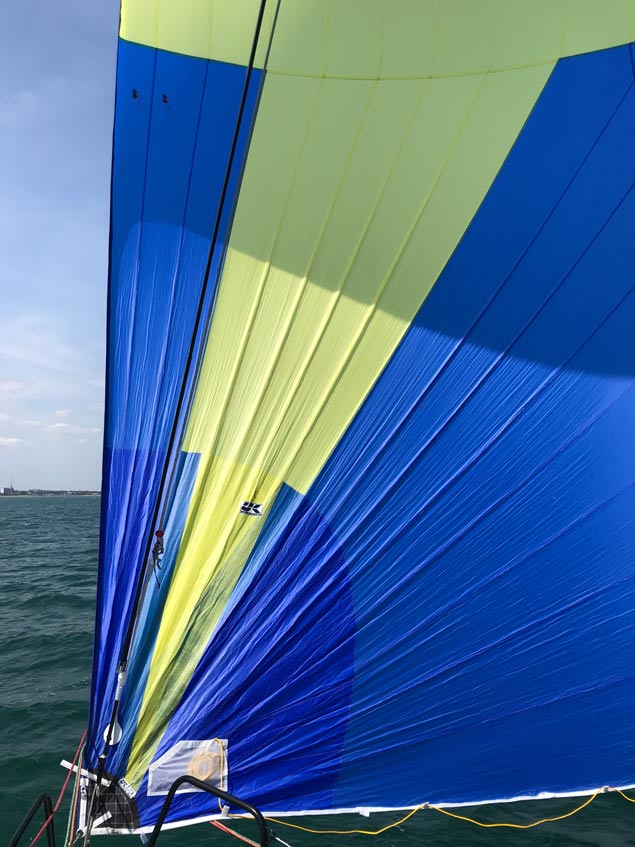
You can see the sail on a tight reach with the sail loaded and the tack ring taking the load. You can also see the tack retriever patch and pull downline. As well as the bungy hoisting system.
After that, the sail is measured for IRC. As we are an in IHC (in-house measurement certified loft) we measure the size of the sail and if its an endorsed IRC cert or One design we put a World Sailing/ISAF sticker on the sail. This is a guarantee the sail is measured within the rating rule. This specific sticker has a specific generic number on it which certifies the sail. We also record the temperature of the sail when we measure it as this can change depending on the time of the year it's measured.
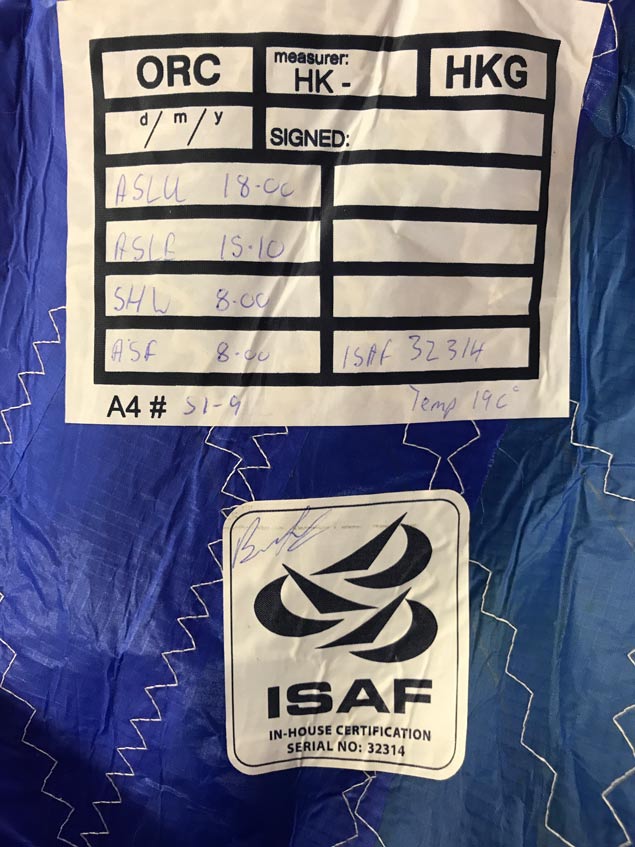
In the final photo, you can see the finished sail flying on the boat.
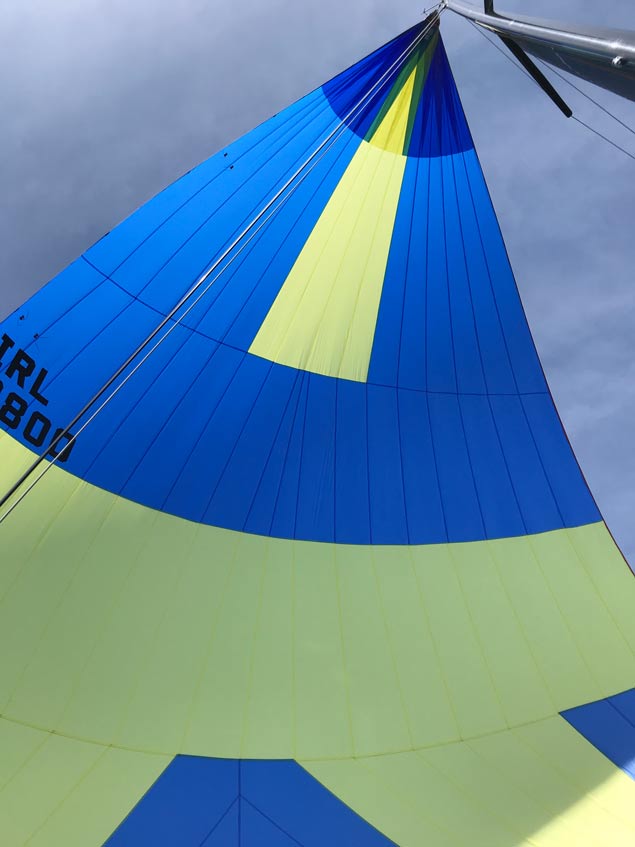
When you order a sail from a loft that produces sails in Ireland, apart from the obvious benefit of supporting home-produced goods, you ensure that if any changes are needed, they can be done quickly and efficiently by properly qualified sailmakers.
Barry Hayes, Director of Uk Sails Ireland, managed the Main UK Production facility for UK Sails in Hong Kong until last October and has been a sail designer with UK sails for over 15 years.


























